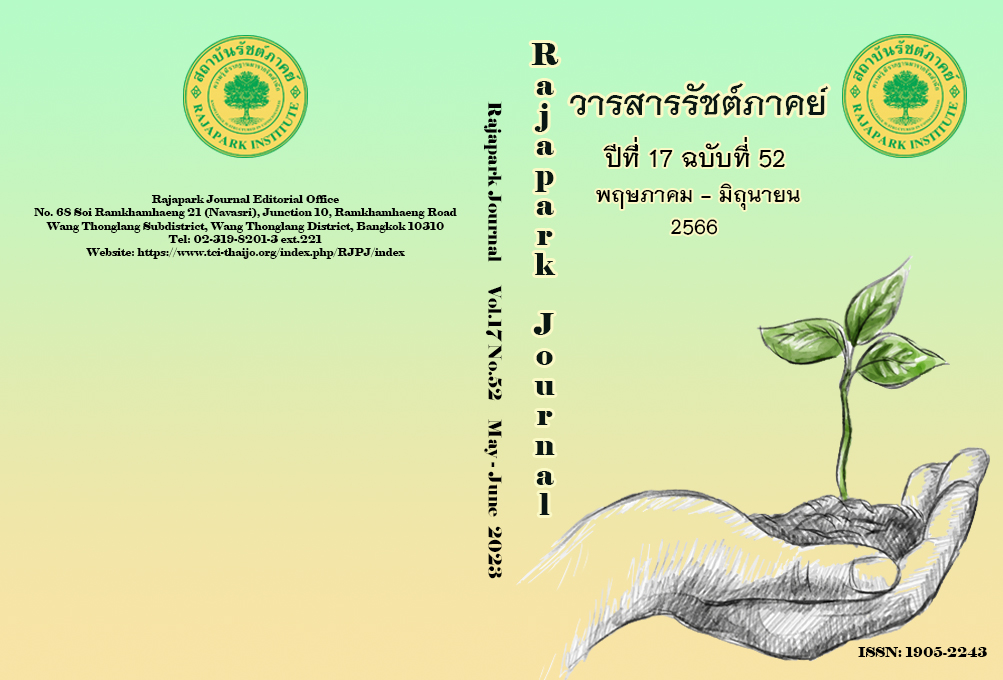Development of Neutral Mask Exercises for Teaching Acting at Advanced Level
Main Article Content
Abstract
The purpose of this research was to develop a neutral mask exercise for teaching acting at a high level and to be used to develop performing arts learners in higher education and other levels. This research uses experimental research. The sample used in the study was selected by purposive sampling. It is a volunteer group of six people who have experience in acting and a professional career. The instrument to collect data was an assessment form used in the research. The data were analyzed using an estimation scale, namely, the mask exercise assessment form (5 exercises) was the most suitable at the highest level; before at the moderate level of 3.01 after at the highest level of 4.35. The research found that there are four important elements in the development of neutral mask exercises: 1) The concept about neutral mask exercises 2) The theory of performance (The Method) 3) The concept of the actor who puts his mind into the character (Emotional Actor), and 4) The concept of the essential skill of the actor. New knowledge was developed from the research, namely 5 mask exercises: 1) Exercise 1: Acceptance 2) Exercise 2: Virtual Role 3) Exercise 3: Deep of Feeling 4) Exercises 4: Mask storytelling, and 5) Exercise 5: Removing the mask (Self-Sacrifice).
Article Details

This work is licensed under a Creative Commons Attribution-NonCommercial-NoDerivatives 4.0 International License.
Views and opinions appearing in the Journal it is the responsibility of the author of the article, and does not constitute the view and responsibility of the editorial team.
References
Brooke, S. (2012). Making the Case for a Mandatory Introductory Acting Class in the General Education Paradigm[Master’s thesis, The California State University].
Cole, L. (2013, Nov). Teaching Commedia Dell’ Arte, Part I. https://broadwayeducators.com/teaching-commedia-dell-arte-part-i/
Joyraksa, N. (2017). What Do You Get from Acting?. https://storylog.co/story/56bf3c8d3c6195db3ccc7af6
Rutnin, M. (2003). Introduction to the Art of Theater Directing. Thammasat University.
Rutnin, M. (2016). The Art of Drama (Acting), Basic Principles and Practice (2nd ed.). Thammasat University.
Powell, M. (2010). The Acting Bible: The Complete Resource for Aspiring Actors. Sourcebooks.
Praditthaen, T. (2019). The Acting Process of Thai Actors[Doctoral Dissertation, Srinakharinwirot University].
Punpeng, G. (2021). Phillip Zarrilli’s Psychophysical Acting Approach. Academic Journal for the Humanities and Social Sciences Dhonburi Rajabhat University, 4(3), 138-151.
Shaw, C. (2014). Masked to Unmasked: The Value of Mask Work in Actor Training[Master’s thesis, The California State University].
Sukbunjhong, S. (2003). A Study of Viewpoints About the Desirable Characteristics of Stage Actors in Thailand[Master’s thesis, Srinakharinwirot University].
Maneewatana, C. (2007). Knowledge of Theater Arts. Teaching documents for academic courses Performance 1. Faculty of Fine and Applied Arts, Suan Sunandha Rajabhat University.
Medhanee, S. (2020). Guidelines for the Development of Basic Acting Exercises for Learners in the 21st Century. Journal of Rattana Bundit University, 15(1), 54-67. https://so03.tci-thaijo.org/index.php/rbac/article/view/244489
Weber, D. (2016). Faith in the Arts of Acting Training[Master’s thesis, The California State University].
Wright, V. (2015, Jan). Making Face Theatre. https://makingfacestheatre.co.uk/about/


